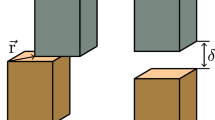Abstract
Consideration of the martensitic nucleation process as a sequence of steps which take the particle from maximum to minimum coherency leads to the hypothesis that the first step in martensitic nucleation is faulting on planes of closest packing. It is further postulated that the faulting displacements are derived from an existing defect, while matrix constraints cause all subsequent processes to occur in such a way as to leave the fault plane unrotated, thus accounting for the observed general orientation relations. Using basic concepts of classical nucleation theory, the stacking fault energy is shown to consist of both volume energy and surface energy contributions. When the volume energy contribution is negative, the fault energy decreases with increasing fault thickness such that the fault energy associated with the simultaneous dissociation of an appropriate group of dislocations (e.g. a finite tilt boundary segment) can be zero or negative. This condition leads to the spontaneous formation of a martensitic embryo. For the specific case of the fcc → hcp martensitic transformation in Fe-Cr-Ni alloys, the defect necessary to account for spontaneous embryo formation at the observedM s temperatures may consist of four or five properly spaced lattice dislocations. Such defects are considered to be consistent with the known sparseness of initial martensitic nucleation sites.
Similar content being viewed by others
References
L. Kaufman and M. Cohen:Progr. Metal Phys., 1958, vol. 7, p. 165.
V. Raghavan and M. Cohen:Acta Met., 1972, vol. 20, p. 333.
C. L. Magee:Phase Transformations, p. 115, ASM, 1970.
R. E. Cech and D. Turnbull:Trans. AIME, 1956, vol. 206, p. 124.
G. B. Olson and M. Cohen:Met. Trans. A, vol. 7A, 1976, pp. 1905–14.
G. B. Olson and M. Cohen:Met. Trans. A, vol. 7A, 1976, pp. 1915–23.
M. S. Wechsler, D. S. Lieberman, and T. A. Read:Trans. AIME, 1953, vol. 197, p. 1503.
J. S. Bowles and J. K. Mackenzie:Acta Met., 1954, vol. 2, p. 129.
R. W. Guard and M. E. Fine:Trans. TMS-AIME, 1965, vol. 233, p. 1383.
J. P. Hirth:Met. Trans., 1970, vol. 1, p. 2367.
R. de Wit and R. E. Howard:Acta Met., 1965, vol. 13, p. 655.
A. P. Miodownik: Unpublished research, University of Surrey, England, 1974.
J. W. Gibbs:The Scientific Papers of J. Willard Gibbs, Dover, 1961.
J. D. Eshelby:Roy. Soc. London Proc., 1957, vol. A241, p. 376.
F. Lecroisey and A. Pineau:Met. Trans., 1972, vol. 3, p. 387.
F. Lecroisey: Doctoral Thesis, University of Nancy, France, 1971.
J. F. Breedis and L. Kaufman:Met. Trans., 1971, vol. 2, p. 2359.
G. B. Olson: Sc.D. Thesis, Massachusetts Institute of Technology, June 1974.
A. Pineau: Unpublished research, Ecole des Mines, Paris, France, 1974.
T. Ericsson:Acta Met., 1966, vol. 14, p. 853.
J. P. Hirth and J. Lothe:Theory of Dislocations, McGraw-Hill, 1968.
J. W. Christian:The Mechanism of Phase Transformations in Crystalline Solids, p. 129, Institute of Metals Monograph No. 33, 1969.
J. A. Venables:Phil. Mag., 1962, vol. 7, p. 35.
E. Votava:Acta Met., 1960, vol. 8, p. 901.
M. Umemoto and W. S. Owen:Met. Trans., 1974, vol. 5, p. 2041.
A. S. Sastri and D. R. F. West:J. Iron Steel Inst., 1965, vol. 203, p. 138.
A. E. H. Love:The Mathematical Theory of Elasticity, Cambridge University Press, 1927.
Author information
Authors and Affiliations
Additional information
This paper is Part I of a three-part series based on a thesis submitted by G. B. Olson for the degree of Sc.D. in Metallurgy at the Massachusetts Institute of Technology in June 1974.
Rights and permissions
About this article
Cite this article
Olson, G.B., Cohen, M. A general mechanism of martensitic nucleation: Part I. General concepts and the FCC → HCP transformation. Metall Trans A 7, 1897–1904 (1976). https://doi.org/10.1007/BF02659822
Received:
Issue Date:
DOI: https://doi.org/10.1007/BF02659822




